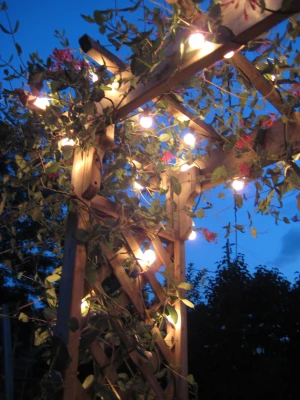What a difference a year makes. The span of time between putting my first herb seedlings into a freshly filled raised bed and harvesting from second year plants is relatively brief–just over one year. But for an herb, that one year makes the difference between infancy and adulthood.
In spring of 2009, I recruited my husband to build a raised bed to be used specifically for herbs. Only 18 inches wide, it’s easily accessed from either side, and herbs have room to spill over the sides if necessary. It also provides a nice border for the small patio garden where most of my garden grows.

Newly built raised bed with seedlings.
In 2009, I planted parsley, chives, dill, sage, rosemary, thyme, lavender, oregano and basil in the raised bed. All grew, though some did better than others. The rosemary never grew taller than six inches, and remained thin. The dill did fine for a few weeks but seemed to go to seed very quickly, and since I did not sow a second or third crop we didn’t have any by the time other veggies were ready to harvest.
Overall, I was pleased with the abundance of parsley, chives, sage, lavender and oregano. That summer I came to know the herb garden and all of it’s smells and flavors.

First year herb garden mid-season.
But it was the following year in which the herb garden really came into it’s own. Early spring saw chives shooting up through the snow. Soon after, tiny green leaves began to grow on what looked like dead wood of thyme, oregano, sage and lavender.
Rosemary and parsley did not survive the winter. It’s just as well. I found a new spot in the bed for the parsley and moved rosemary to a pot where it has been much happier. Now the rosemary can come inside with me for the winter and be used in winter soups and sauces.

Potted rosemary can live indoors or out.
Year two was one of pruning back. The sage became huge, almost tree-like in the way it became thick and woody, stems reaching all over the place. Chives needed constant cutting. In fact, by the end of the season I removed three plants, knowing I wouldn’t need them next year. This could free up space for something new.
The best part of the herbs’ second year was the beautiful flowers. All edible, all beautiful. And they attracted the most interesting insects and butterflies to our garden. I can’t wait till next year when the flower show begins again.

Herb garden, year two. Basil in nearby container.

Lavender flowers delighted us all season.

A sea of herbs.
I wonder what the herb garden will look like in its’ third year? Will it overgrow its small space? Will plants come back just as healthy? Will I need to replant anything? I especially wonder about that parsley. Biennial, it should come back this spring if conditions are right.
Time will tell how the herb garden will grow. After two years with it, I know this: I’ll never have a home without an herb garden again. Herbs brighten up our food, look and smell great in the garden and are a conversation piece for guests to our home. They attract butterflies and hummingbirds. My kids can’t help but grab an herb and munch on it while they play outside. We’ve come to appreciate our herb garden more than we could have imagined when we first set out. I simply love my herb garden.






























